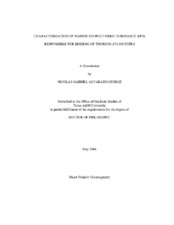| dc.description.abstract | The functional group composition of acid polysaccharides was determined after isolation using cross-flow ultrafiltration, radiolabeling with 234Th(IV) and other isotopes, and separation using isoelectric focusing (IEF) and polyacrylamide gel electrophoresis (PAGE). Phosphate and sulphate concentrations were determined from cultured bacterial and phytoplankton colloid, particulate and colloidal samples collected from the Gulf of M??xico (GOM). Characterization of the 234Th(IV)-binding biomolecule was performed using ion chromatography (IC), and gas chromatography-mass spectrometry (GC-MS). Radiotracer experiments and culture experiments were conducted in determining the binding environment of the 234Th(IV)-binding ligand (i.e., sorption onto suspended particles), as well as the origin of the ligand in seawater systems. In all samples, 234Th(IV) isoelectric focusing profiles indicated that 49% to 65% of the 234Th(IV) labeled EPS from Roseobacter gallaeciensis, Sagittula stellata, Emiliania huxleyi, Synechococcus elongatus and GOM Station 4-72m was found at a pHIEF of 2 in the IEF spectrum. The carboxylic acid group appeared at the same pHIEF as 234Th(IV) for EPS from Roseobacter gallaeciensis, Emiliania huxleyi, Synechococcus elongatus and GOM colloidal organic matter sample. The phosphate group appeared at the same pHIEF as 234Th(IV) for EPS from Roseobacter gallaeciensis, and Synechococcus elongatus sample. The sulphate group was found at the same pHIEF as 234Th(IV) for EPS from S. elongatus and GOM colloidal organic matter sample. The total polysaccharide content was only 14% and 8%, uronic acids were approximately 5.4% and 87.1%, and total protein content was 2.6% and 6.2% of total carbon content of Sagittula stellata and Synechococcus elongatus, respectively. Monosaccharides identified in both Sagittula stellata and Synechococcus elongatus were galactose, glucose, and xylose in common. In addition, Sagittula stellata contained mannose and Synechococcus elongatus had galactoglucuronic acid. Thus, depending on the species, the size, structural composition, and functional groups of the 234Th(IV)-binding, acidic polysaccharides will vary. From these observations, it is concluded that the steric environment and not necessarily the exact functional group might actually be responsible for thorium-234 complexation to macromolecular organic matter. This research helped to improve our understanding of the observed variability in POC/234Th ratios in the ocean and provided insights into factors that regulate organic carbon export fluxes. | en |


